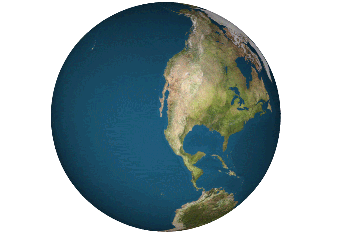The Dymaxion map (that strange, 20-sided globe) in the Ellison Hall lobby originally belonged to the Buckminster Fuller Institute in Santa Barbara, and when that was moved to Stanford in 1999, the map was given to the Department of Earth & Planetary Sciences at Santa Barbara City College. SBCC gave it to UCSB Geography in 2007, and Geography Professor and Researcher Emeritus Don Janelle built the platform for it (source: personal communication with research support staff member Karen Doehner and alumnus Mike Vergeer – Mike got his MA in 2004 and currently teaches Earth & Planetary Sciences at SBCC).
The Dymaxion map or Fuller map is a projection of a world map onto the surface of an icosahedron, which can be unfolded and flattened to two dimensions. The flat map is heavily interrupted in order to preserve shapes and sizes. The map was created by Buckminster Fuller. The 1954 version published by Fuller, the Airocean World Map, used a modified but mostly regular icosahedron as the base for the projection, which is the version most commonly referred to today. This version depicts the Earth’s continents as “one island,” or nearly contiguous land masses. The name Dymaxion was applied by Fuller to several of his inventions. It is a portmanteau of the words dynamic, maximum, and tension (source)
“Using the form of an icosahedron, a polyhedron with 20 triangular faces, Fuller was able to accurately depict the whole earth on a flat map with only the tiniest bit of distortion, not even visible to the human eye, distributed among the triangles uniformly. Each edge of the 20 triangles has absolute accuracy, like paper touching the equator in a Mercator map. This makes Fuller’s map the first map in history to depict a true picture of our earth on a flat plane, which can be used flat or folded up into 3-dimensions. Although the oceans in Fuller’s map are broken, the triangles themselves can be rearranged into dozens of other useful configurations, depending on what you want to look at” (source).
“R. Buckminster Fuller was a renowned 20th century inventor and visionary born in Milton, Massachusetts on July 12, 1895. Dedicating his life to making the world work for all of humanity, Fuller operated as a practical philosopher who demonstrated his ideas as inventions that he called ‘artifacts.’ Fuller did not limit himself to one field but worked as a ‘comprehensive anticipatory design scientist’ to solve global problems surrounding housing, shelter, transportation, education, energy, ecological destruction, and poverty. Throughout the course of his life, Fuller held 28 patents, authored 28 books, and received 47 honorary degrees. And while his most well-known artifact, the geodesic dome, has been produced over 300,000 times worldwide, Fuller’s true impact on the world today can be found in his continued influence upon generations of designers, architects, scientists, and artists working to create a more sustainable planet” (source).
R. Buckminster (“Bucky”) Fuller is also famous for his quotes. Perhaps his most famous one is “You never change things by fighting the existing reality. To change something, build a new model that makes the existing model obsolete.” One of Mike Vergeer’s favorites is “When I am working on a problem, I never think about beauty…….. but when I have finished, if the solution is not beautiful, I know it is wrong.”





